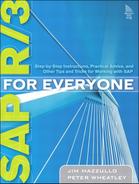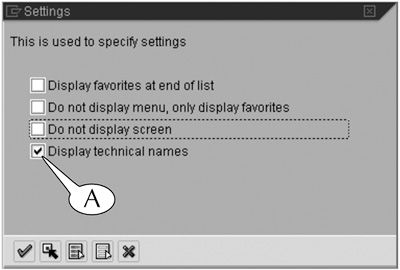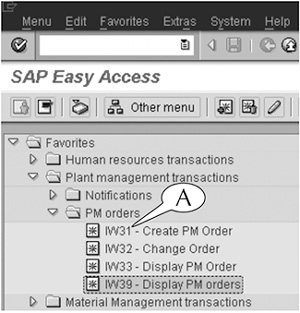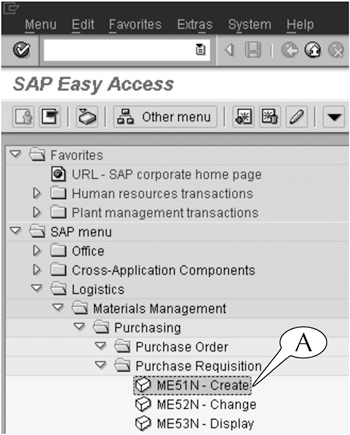Lesson 7 Navigating to Initial Screens With Transaction Codes
This lesson describes the use of transaction codes to navigate to the initial screens of transactions.
Every SAP transaction is assigned its own unique transaction code or t-code, which is often used as a shorthand name for the transaction itself. The codes are usually four or five characters long, although they can be longer, and they are organized according to their functions, which are often indicated in the transaction code itself. For example:
![]() Purchasing transactions have four- and five-character codes that begin with ME. For instance, you can create a purchase requisition with the ME51N transaction, display a list of requisitions from your department with the ME5A transaction, and create a vendor purchase order for an approved requisition with the ME59 transaction.
Purchasing transactions have four- and five-character codes that begin with ME. For instance, you can create a purchase requisition with the ME51N transaction, display a list of requisitions from your department with the ME5A transaction, and create a vendor purchase order for an approved requisition with the ME59 transaction.
![]() Equipment-maintenance transactions have four-character codes that begin with IW. For instance, you can create a work order for maintaining a vehicle with the IW31 transaction, display the costs of that work with the IW33 transaction, and close the books on the work with the IW32 transaction.
Equipment-maintenance transactions have four-character codes that begin with IW. For instance, you can create a work order for maintaining a vehicle with the IW31 transaction, display the costs of that work with the IW33 transaction, and close the books on the work with the IW32 transaction.
![]() Reporting transactions often have very long codes because there are so many varieties of them. For instance, you can display a yearly budget for a department with the S_ALR_87013611 transaction and a yearly budget for a large work project with the S_ALR_87013543 transaction. But you can also display the monthly budget of a project with the S_ALR_87013614 transaction and display the budget for each contractor working on that project with the S_ALR_87013615 transaction.
Reporting transactions often have very long codes because there are so many varieties of them. For instance, you can display a yearly budget for a department with the S_ALR_87013611 transaction and a yearly budget for a large work project with the S_ALR_87013543 transaction. But you can also display the monthly budget of a project with the S_ALR_87013614 transaction and display the budget for each contractor working on that project with the S_ALR_87013615 transaction.
You can navigate to the initial screen of transactions by entering their transaction code in the command fields of screens. This navigation method can be used on the SAP Easy Access screen, where it provides a rapid, keyboard-driven alternative to pointing-and-clicking through the menu or favorites folders to a transaction link, as well as on any initial or output screen.
To navigate from the SAP Easy Access screen to the initial screen of any transaction, simply enter its transaction code in the command field (Figure 7.1A), then hit the Enter key on your keyboard, and the initial screen appears.
To navigate from any other screen (initial or output) to the initial screen of any transaction, enter the prefix /n or /o, followed by the transaction code, in the command field and hit the Enter key on your keyboard (Figure 7.2). The prefix instructs the system that you are interrupting the present transaction to start a new one.
![]() When you attach the /n prefix to a transaction code (A), the initial screen of the new transaction is displayed inside the existing application window.
When you attach the /n prefix to a transaction code (A), the initial screen of the new transaction is displayed inside the existing application window.
![]() When you attach the /o prefix to a transaction code (B), the initial screen of the new transaction is displayed inside a new application window, which is automatically opened by the system.
When you attach the /o prefix to a transaction code (B), the initial screen of the new transaction is displayed inside a new application window, which is automatically opened by the system.
Figure 7.2 Navigating from other screens to start a new transaction in the same application window (A) or in a new application window (B).

You can also select and enter a transaction code in the command field from its list menu, where your most recently entered transaction codes are recorded. Just follow this next procedure.
Procedure
Selecting Transaction Codes From the Command Field List Menu
Step 1. Click the list icon at the right end of the command field (Figure 7.3A) to display a list menu of recently entered transaction codes (B).
Step 2. Scroll down the menu and click a transaction code, and it is entered in the command field.
Note: You must follow the usual protocol when you are making this selection: select a raw transaction code (for example, IW33) whenever you are navigating from the SAP Easy Access screen, or an appended code (for example: /nIW33 or /oIW33) whenever you are navigating from any other screen.
Step 3. Hit the Enter key on your keyboard, and the initial screen appears.
End Procedure
Finally, you can manage the application window by entering the following codes in the command field:
![]() Enter /n and hit the Enter key to end a transaction. The system returns you to the SAP Easy Access screen without asking you to confirm this action, and any data that you entered on the transaction screens is not saved.
Enter /n and hit the Enter key to end a transaction. The system returns you to the SAP Easy Access screen without asking you to confirm this action, and any data that you entered on the transaction screens is not saved.
![]() Enter /i and hit the Enter key to close a single application window. If there is only one open window, you are asked to confirm that you want to close it and thereby log off from the system.
Enter /i and hit the Enter key to close a single application window. If there is only one open window, you are asked to confirm that you want to close it and thereby log off from the system.
![]() Enter /nex and hit the Enter key to close all your open application windows and log off the system. The system does not ask you to confirm this action before you are logged off.
Enter /nex and hit the Enter key to close all your open application windows and log off the system. The system does not ask you to confirm this action before you are logged off.
![]() Enter /nend and hit the Enter key to close all your open application windows and log off the system. The system does ask you to confirm this action before you are logged off.
Enter /nend and hit the Enter key to close all your open application windows and log off the system. The system does ask you to confirm this action before you are logged off.
Generally, many users learn the transaction codes for the transactions they use for their work from other users in their department or group, as well as from job aids, cheat sheets, and other tools that document the procedures for executing transactions. This mode of communication is made easier by the common use of transaction codes as shorthand names for transactions. For instance, a new employee in a department may be instructed by their manager to enter employees’ work-time data in SAP by “running the CATS2 transaction” or asked to generate a list of pending work orders by “running the IW39 transaction.”
However, you can also identify transaction codes on-screen in several ways.
For instance, you can display the transaction codes of transactions alongside their names in the menu and Favorites folders of the SAP Easy Access screen by following this procedure.
Procedure
Displaying Transaction Codes on the SAP Easy Access Screen
Step 1. Follow the menu path Extras > Settings (Figure 7.4A).
Step 2. The Settings popup screen appears (Figure 7.5).
![]() Select the Display technical names option (A).
Select the Display technical names option (A).
![]() Hit the Enter key on your keyboard.
Hit the Enter key on your keyboard.
Step 3. The transaction codes (A) appear ahead of the transaction links in the menu and Favorites folders (Figure 7.6).
End Procedure
You can also display the code of a transaction from any screen (initial or output) of that transaction through the menu bar or the system data field of the status bar by following these next procedures.
Procedure
Identifying Transaction Codes With the Menu Bar
Step 1. Follow the menu path System > Status (Figure 7.7A).
Step 2. The Status popup screen appears (Figure 7.8). The transaction code is displayed in the Transaction field (A).
Figure 7.8 The System status popup screen displays a wealth of mostly technical information—and the transaction code of the main screen.
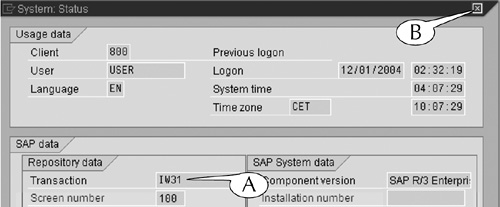
Step 3. Click the close button (B) to erase the Status popup screen.
End Procedure
Procedure
Identifying Transaction Codes With the Status Bar
Step 1. Click the list icon (Figure 7.9A) in the system data field, which lies at the right end of the status bar.
Step 2. The system data menu appears with the transaction code (B).
Note: If you scroll down and select Transaction on this menu so that a check mark appears to its left, the transaction code of the screens will always appear in the status bar of all your screens.
End Procedure
You can search the menu folders and transaction links by transaction code with the Find button (A) of the standard toolbar (Figure 7.10). Follow this next procedure.
Procedure
Searching for Transactions With Keywords
Step 1. Click the Find button (A), or
![]() Hit the Ctrl + F keys on your keyboard.
Hit the Ctrl + F keys on your keyboard.
Step 2. The Search in menu tree popup screen appears (Figure 7.11).
![]() Enter the transaction code in the Find field (A). For this example, we entered the transaction code ME51N.
Enter the transaction code in the Find field (A). For this example, we entered the transaction code ME51N.
![]() Select the In Technical Name option (if it is not already selected) to search by transaction code (B).
Select the In Technical Name option (if it is not already selected) to search by transaction code (B).
![]() Hit the Enter key on your keyboard.
Hit the Enter key on your keyboard.
Figure 7.11 Search for transaction links by transaction codes with the Search in menu tree popup screen.

Step 3. The system expands the menu folders and displays the first occurrence of the transaction code (A), which is highlighted (Figure 7.12).
End Procedure
